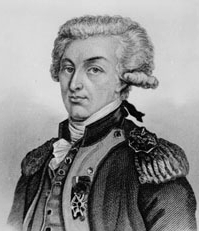General Marie Joseph Paul Yves Roch Gilbert du Motier de Lafayette

Born: September 6, 1757
Place of Birth: Chavaniac, Haute-Loire, France
Died: May 20, 1834
Place of Death: Paris, France
Arc de Triomphe: LAFAYETTE on the north pillar
Pronunciation:
Born into a noble family, Marie Joseph Paul Yves Roch Gilbert du Motier was not quite two years old when his father was killed at the Battle of Minden in the Seven Years War. Inheriting a large fortune and the title of Marquis de Lafayette, he joined the Black Musketeers of the French army in 1771. In 1777 he sailed to North America at the head of a volunteer force to aid the colonists in the American Revolutionary War and he joined the American army as a major general. After campaigning under General Washington, Lafayette returned to France in 1779 to build more support. In 1780 he returned to North America and in 1781 he took an active part in the Siege of Yorktown. After the conclusion of the siege, back in France Lafayette was given the rank of maréchal de camp in the French army.
At the dawn of the French Revolution, Lafayette was a member of the nobility representing the First Estate at the Estates-General. However, as events progressed he supported the Third Estate and he was elected vice president of the National Assembly and appointed head of the National Guard of Paris. Lafayette went on to persuade Louis XVI to use the tricolor and in October he marched the National Guard to Versailles to save the royal family from the Paris mob. In June of 1791 when it was discovered the royal family had escaped Paris and fled, Lafayette ordered their arrest and return to the capital. Next he was promoted to lieutenant général at the end of the month. Lafayette took command of the Army of the Center in December and then in July of 1792 he was transferred to command the Army of the North. By this time he had grown quite alarmed by the direction the French Revolution was headed. The next month Lafayette protested the suspension of the monarchy and he arrested the representatives of the people at Sedan. For these actions he was declared a traitor and ordered arrested, and he and his staff fled France to join the Austrians.
Instead of being welcomed as an émigré like other French nobles, Lafayette was considered a dangerous revolutionary by the Austrians and imprisoned at Olmutz. He remained imprisoned until the autumn of 1797 when General Napoleon Bonaparte gained his release as part of the Treaty of Campo Formio. Lafayette retired to private life and after Napoleon took power Lafayette refused Napoleon's offer to serve as ambassador to the United States. Lafayette also opposed Napoleon being voted Consul for Life and later Emperor of the French.
During the Hundred Days of 1815 when Napoleon resumed power, Lafayette was elected a deputy of Seine-et-Marne and vice president of the Chamber of Representatives. After the loss of the Battle of Waterloo, he drafted a resolution demanding Napoleon's abdication. In the following years he returned to politics repeatedly and in 1824 and 1825 he made a tour of the United States. In 1830 during the political crisis he resumed command of a recreated National Guard and he helped Louis Philippe, the Duke of Orléans, ascend to the throne of France. In his last years he frequently argued with King Louis Philippe over policies. Numerous cities in the United States are named in his honor.
Bibliography
- Chandler, David G. Dictionary of the Napoleonic Wars. New York: Macmillan Publishing, 1979.
- Divry, Arnauld. Les Noms Gravés sur l'Arc de Triomphe. Paris: L'Harmattan, 2017.
- Haythornthwaite, Philip J. Who Was Who in the Napoleonic Wars. London: Arms & Armour, 1998.
Updated October 2021
© Nathan D. Jensen